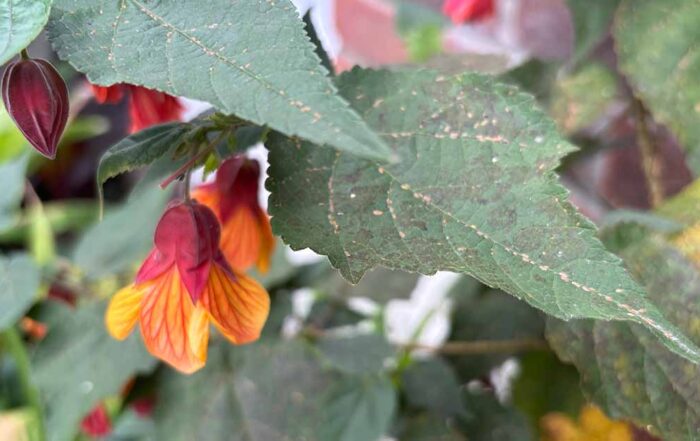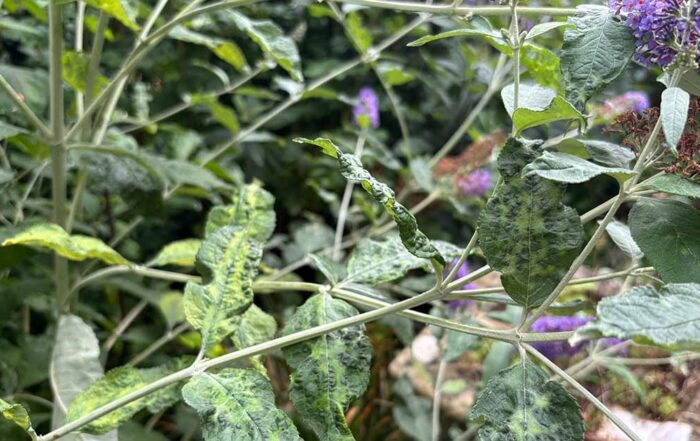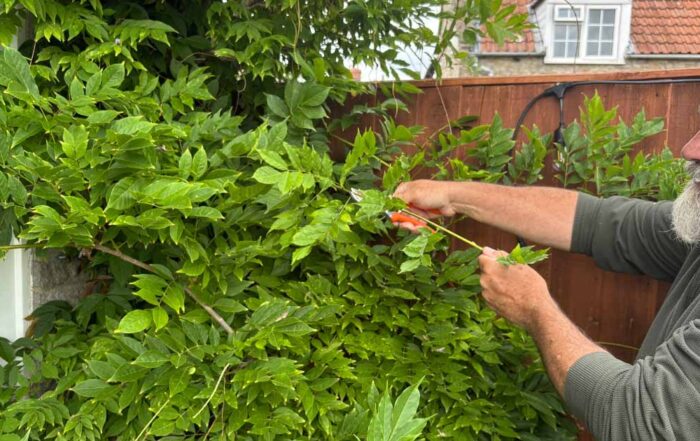Why have the leaves turned brown on my box plants?
Gardeners have noticed a scourge of box bushes that has turned their leaves brown in recent years. First it was box blight, a fungal infections that causes the foliage of plants to die and drop. And now, since it was first reported in the UK in 2007/8, there is box moth to contend with. The moth itself is not what causes the injury to the plants, but its caterpillars do!
It can seemingly turn box bushes brown overnight, by feeding on the leaves and creating mats of fine webbings. Plants can produce new shoots following an attack, but repeated infestations of the caterpillars can weaken the bushes, reducing their vigour and overall health.
What is box moth?
This insect is a member of the lepidoptera which includes butterflies and moths. The adult box moth measures up 45mm across and is predominantly creamy white with grey-brown bands on the front and rear edges of the wings. The outline of the wings is notably triangular in shape, when the insect is resting.
Adults lay their eggs on the undersides of healthy leaves and these hatch out into larvae or caterpillars. Initially small, these are able to eat through the surface of young box foliage, leaving behind the tough underside of the leaf and its tracery of veins. As they grow, however, the caterpillars are able to eat entire leaves. The caterpillar droppings are initially green, but rapidly turn brown as they dry.
Once fully grown to around 40cm in length, the green and black caterpillars pupate. This means that they develop a firm outer casing on the body, which allows the contents of the caterpillar to rearrange into an adult moth. This then emerges from its casing and flies off to mate and lay eggs. It is possible for there to be 3 generations of moths in a single season in the UK. In hotter conditions, 4 generations are not uncommon.
Caterpillars are able to overwinter in cocoons which which they are able to produce using their own silk thread spun around a leaf or young shoot tip.

How can I get rid of box moth caterpillars?
Understanding the lifecycle of the moth and caterpillars, as mentioned above, allows the overwintering cocoons to be picked off the plants before the adults emerge on spring. However, new infestation from neighbours’ plants is all too easy as emerging adults can easy fly to your plants to lay their eggs.

Pheromone lures can be used to attract the adult moths, and them trap them on a sticky surface. This helps to reduce the numbers of moths immediately around your plants, but again has limited effect on adults flying in from the surrounding area. Such traps also need to be fresh and within date when purchased. The traps should be in place from March to April and during October and November to optimise trapping during the adult stage of the lifecycle.
More effective control can be afforded by using Bacillus thuringiensis kurstaki, a bacterium that produces a toxin that is specific to insects. However, this is not legally permitted for use in the UK.
However, there is now a nematode biological control available. A number different species of these microscopic worms are used to help control slugs, vine weevil, chafer grubs and other garden pests. They need to be supplied and applied fresh and in strictly accordance with the application instructions, watered or sprayed on. The nematodes burrow into the body of the pests – in this instance the caterpillars – where they replicate and eat them from the inside-out.
Meantime, giving box bushes some additional nutrients can help them toughen up and lessen the chance of severe infestation, both by box moth caterpillars AND box blight fungus. High-potash fertiliser is best which will make the foliage more resilient and less palatable to pests and diseases. Apply sulphate of potash a couple of times a year, once in March, just before growth starts and then again in July.
Alternatively liquid tomato fertiliser or homemade comfrey fertiliser can be used, diluted in a watering can and applied to the base of the plants and directly onto the foliage of the plants using a fine rose. Use at 6-8 week intervals from April to August. Avoiding applications of high-nitrogen fertilisers and manures will reduce the development of soft growth and foliage.
Does box moth caterpillar eat other plants?
Thankfully box moth caterpillar does not feed extensively on other plants, although it has been noted on some species of spindle (Euonymus) and holly (Ilex) Neither of these are damaged severely by box moth caterpillar.
It is important to note, however, that it is a separate moth species – the spindle ermine moth – that causes such huge damage to euonymus in the UK and Europe. By comparison holly is relatively little damaged by its specific holly tortrix moth.
Share This Story!
Are alstoemerias good garden plants?
Although we see them regularly in bouquets of cut flowers, alstroemerias also make good garden plants. Also known as Peruvian lilies or lily of the Incas, they've not been widely grown in UK gardens, .....
How do I summer prune wisteria?
There’s something utterly enchanting about wisteria in full bloom, but the problem for many gardeners can be how to prune it. Wisteria is a vigorous grower, and left unchecked, it can quickly become a .....
Are alstoemerias good garden plants?
Although we see them regularly in bouquets of cut flowers, alstroemerias also make good garden plants. Also known as Peruvian lilies or lily of the Incas, they've not been widely grown in UK gardens, .....
What is the best scented flower for winter?
It's official, I have a passion for daphnes and in my opinion these are the best plants for scented flower in late winter. Don't get me wrong, they're not new to me. But they .....
How do I summer prune wisteria?
There’s something utterly enchanting about wisteria in full bloom, but the problem for many gardeners can be how to prune it. Wisteria is a vigorous grower, and left unchecked, it can quickly become a .....
What is the best time to sow beans?
Beans are an easy and rewarding crop to grow for summer and the best time to sow them is in the spring. This will produce early plants that will start producing a crop in .....








